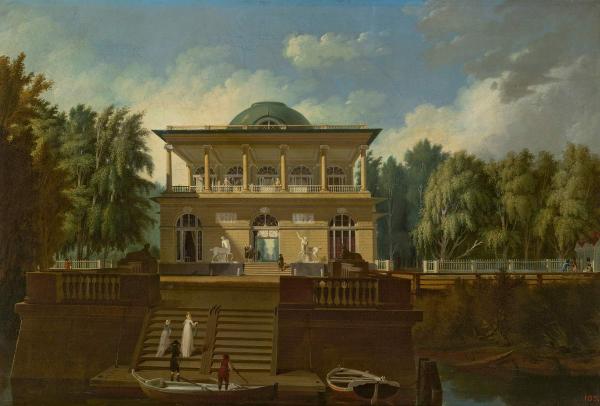The artist is Voronikhin

For this picture, the artist received the title of academician of promising and miniature painting (1797). The cottage was built (1795–1796) according to the project of architect A. N. Voronikhina (according to some information, built by the architect f. And. Demeretsov in 1793, rebuilt Voronikhin in 1796–1797) in St. Petersburg at the confluence of the Black River in Bolshaya Nevka. Belonged to Count a. With. Stroganov. In 1909, the building was radically rebuilt, and in the 1970s it was dismantled.
The landscape plays the facade of the cottage, decorated with a colonnade, from the estate to the river is a granite staircase decorated with sculptures of lions and centaurs. The walls of the first stone floor are cut out on both sides with three high aorous openings. According to contemporaries, the second floor was wooden, and in its central part there was a hall in which balls and meetings were arranged. Instead of walls, the hall was surrounded by glazed Palladian windows, separated by columns. In its left side were choirs for musicians. On both sides of the hall were open galleries with colonnades of the Ionian Order. The construction of four gables ended, over which the dome with the Belvedere rises. It was at this country that the Stroganov holidays known to contemporaries took place. The description of one of these holidays was left to descendants by the French artist E. VIZH-LEVELMENT: "For about three hours we went up to the terrace surrounded by columns, where the day surrounded us from all sides. On the one hand, one could enjoy the view of the park, on the other, loaded with thousands of boats, one another elegant … On this terrace we had lunch. The lunch was magnificent …, the music was heard (was) … After lunch, we took an unforgettable walk in the garden, in the evening we went up to the terrace, from where we watched… Beautiful fireworks… The lights reflected in the waters of the Neva produced a magical effect".
The work was written in the traditions of the old Western school, which on Russian soil were subjected to creative interpretation. The landscape of the architect has characteristic features "Topographic" landscapes: an image of a real place and the estate of the eminent people of the Stroganovs.
Leave a Reply